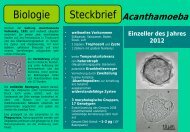Paramecium - Deutsche Gesellschaft für Protozoologie / German ...
Paramecium - Deutsche Gesellschaft für Protozoologie / German ...
Paramecium - Deutsche Gesellschaft für Protozoologie / German ...
You also want an ePaper? Increase the reach of your titles
YUMPU automatically turns print PDFs into web optimized ePapers that Google loves.
New choanoflagellate species from Deep Sea and from<br />
brakish waters<br />
Frank Nitsche 1 , Hartmut Arndt 1 , Markus Weitere 1 , Frank Scheckenbach<br />
1 ,Klaus Hausmann 2 , Claudia Wylezich 1<br />
1 Universität zu Köln, Allg. Ökologie<br />
2 Freie Universität Berlin, Institut <strong>für</strong> Biologie/Zoologie<br />
Despite their high abundance and their high importance for the oceanic<br />
matter flux, heterotrophic nanoflagellates are only poorly studied<br />
in the deep-sea regions. Studies on the choanoflagellate distribution<br />
during two deep-sea expeditions, to the South Atlantic (5038 m) and<br />
Antarctica (Weddell Sea, 2551 m), revealed the deepest records of<br />
choanoflagellates so far. A new species, (Lagenoeca antarctica) with<br />
a conspicuous spike structure on the theca is described from deep<br />
Antarctic waters. A second species, Salpingoeca abyssalis sp. n., was<br />
isolated from the abyssal plain of the South Atlantic (5038 m depth).<br />
Floating and attached forms were observed. Phylogenetic analyses<br />
based on a fragment of SSU rDNA revealed Salpingoeca abyssalis to<br />
cluster together with a marine isolate of Salpingoeca infusionum<br />
while Lagenoeca antarctica clusters separately from the other codonosigid<br />
and salpingoecid taxa. Salpingoeca abyssalis and an undetermined<br />
Monosiga species seems to be the first choanoflagellate species<br />
recorded from the abyssal plain.<br />
Additionally, a new species of acanthoecid choanoflagellate isolated<br />
from brackish waters of the Danshui estuary in North Taiwan is described.<br />
Due to the similar morphology shered with Diplotheca<br />
costata the new species has been placed in the same genus and named<br />
Diplotheca elongata. A phylogenetic analysis of partial SSU rDNA<br />
sequences from Diplotheca costata and D. elongata supports this<br />
taxonomic affiliation. This is a large and distinctive choanoflagellate<br />
which has not been reported in any previous study, suggesting that it<br />
may be an endemic species of restricted distribution.<br />
nitsche_frank@hotmail.com<br />
56





